Hospital Ship
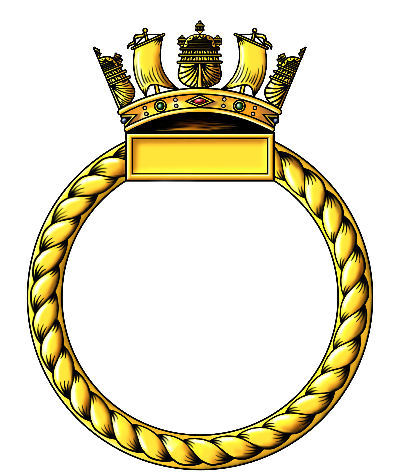
No badge issued for this vessel
Battle Honours
None
Specification
Builder: Alexander Stephen & Sons Ltd., Govan, Scotland
Displacement: 4,820 Gross tons
Length: 429.8 ft
Beam: 53.3 ft
Draught: 22.9 ft
Propulsion: 2 x Alexander Stephen & Sons Ltd Triple-expansion steam engine, two propellers, 6.400 Bhp
Speed: 16 Knots
Armament: None
Crew complement: Unknown
Commanding Officers
Captain R. H. A. Bond October 1939
Captain E. C. Brookes October 1945
Senior Medical Officer
Surg. Captain F. G. Hunt, MRCS, LRCP October 1939
Surg. Captain R. A. Brown, MB, CHB March 1942
Surg. Cdr. D. R. F. Bertram, OBE, MB, MS, DMR April 1944
Related items
None
Reminiscences
None
Gallery
None
H.M.H.S. VASNA
Read aloud
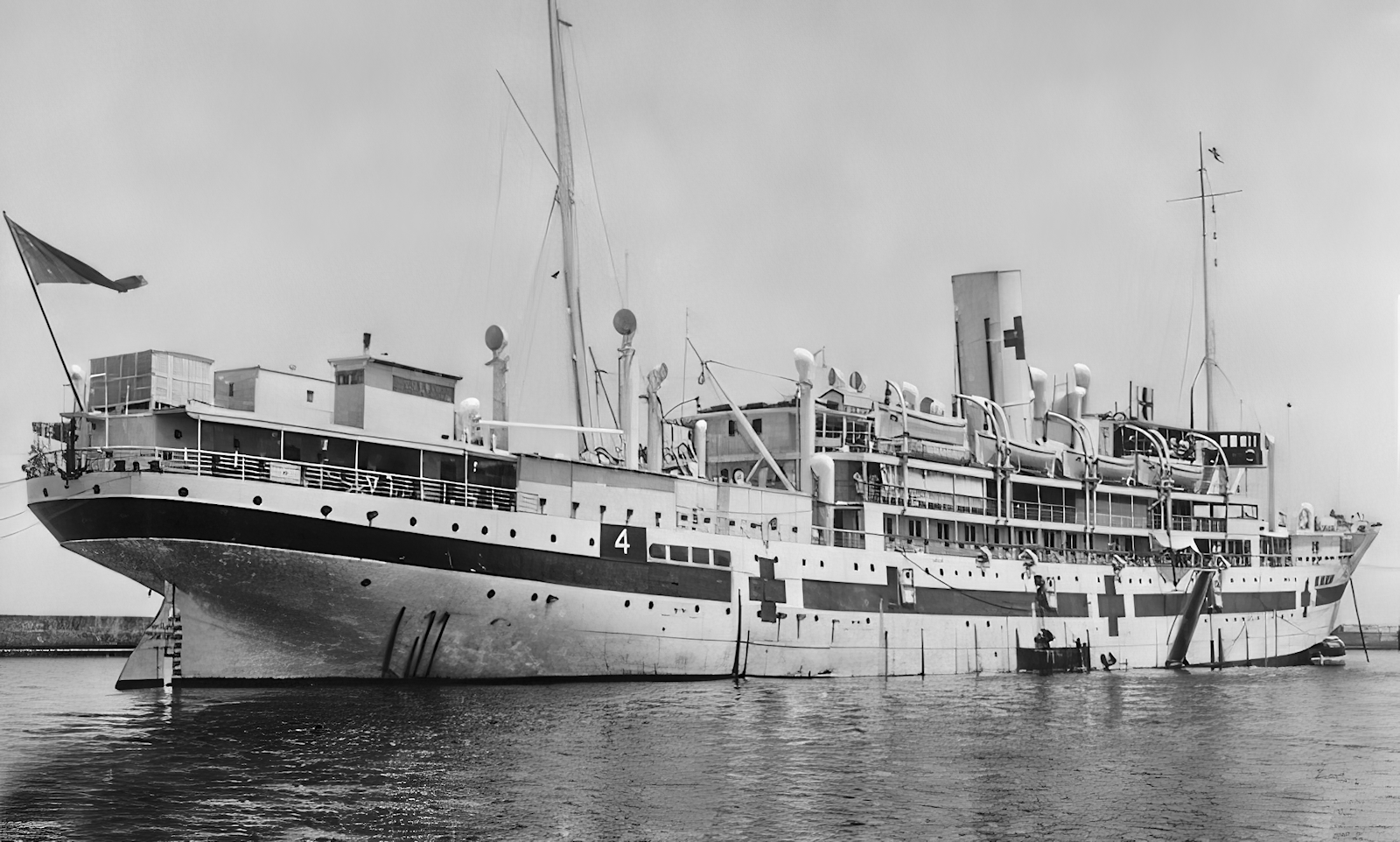
VASNA, Hospital Ship No.4 in 1939
Early history: WW1 Hospital Ship
VASNA was a 4,820 grt Passenger/Cargo ship ordered by the British India Steam Navigation Co. Ltd., Glasgow from Alexander Stephen & Sons Ltd., shipbuilders, Govan, Glasgow. She was laid down as Yard number 465 and designed to accommodate 1,661 passengers; 29 1st, 27 2nd, and 1605 deck passengers and 2,800 cubic feet of refrigerated cargo.
She was requisitioned on May 29th 1917 while still building and was completed as a Hospital ship on June 30th 1917. She was the last of four V-class ships to be delivered and for the British India Steam Navigation Co.
On departure from her builder’s yard she sailed as an Indian Expeditionary Force hospital ship Joining her sisters VARELA, VARSOVA and VITA for service in the Persian Gulf. She was outfitted with a mixture of Cots and berths could accommodate 558 wounded and sick, including 32 officers, 16 British and 16 Indian, 9 Warrant Officers, 57 cot cases and 460 berths.
She arrived at Bombay on August 25th after making her maiden voyage from Glasgow down the West coast of Africa calling at Cape Town before crossing the Indian Ocean. The ship was crewed by the merchant navy and the hospital by a mix of army units under Major G. Franklin, I.M.S. as senior medical officer also Officer Commanding Troops.
VASNA was an “Indian” Hospital Ship under the military command of the Indian [Army] Medical Service (I.M.S.). Consequently, she carried a large Indian staff along with the British one. There would have been as many as 100 Indian staff members on board filling a variety of roles such as sub-assistant surgeons, dispensers, Hindu and “Mohammedan” cooks, tailor, sweepers, dhobis, ward orderlies and servants. Doctors and Surgeons were drawn from both the RAMC and I.M.S. In addition to their medical duties, these men also filled administrative duties, for example the roles of Adjutant, Surgical & Medical Stores officer, C.O. RAMC, and C.O. Indian Personnel.
A small Female nursing staff of Ward Sisters, Staff Nurses and probationary Nurses included women from the Australian Army Nursing Service (A.A.N.S.), the Queen Alexandra’s Military Nursing Service, India (Q.A.M.N.S.I.), Queen Alexandra’s Imperial Military Nursing Service Reserve (Q.A.I.M.N.S.R.), and the South African Military Nursing Service (S.A.M.N.S.); they came under the command of an on-board Matron and a Sister-in-Charge. Some of her medical personnel had embarked in South Africa, one medical officer, 7 nursing sisters and 68 Indian personnel joined her at Bombay prior to sailing for Basra, Iraq, at the head of the Persian Gulf to begin operations.
VASNA sailed from Bombay on her first run to Basra on August 30th 1917, entering the Persian Gulf on September 3rd, entering the at Shatt-al-Arab river, Iraq, on the 5th and arriving at Basra on the 6th. After only four days in port she sailed back down the Persian Gulf to calling at Karachi on the 15th and arriving back at Bombay on the 18th.
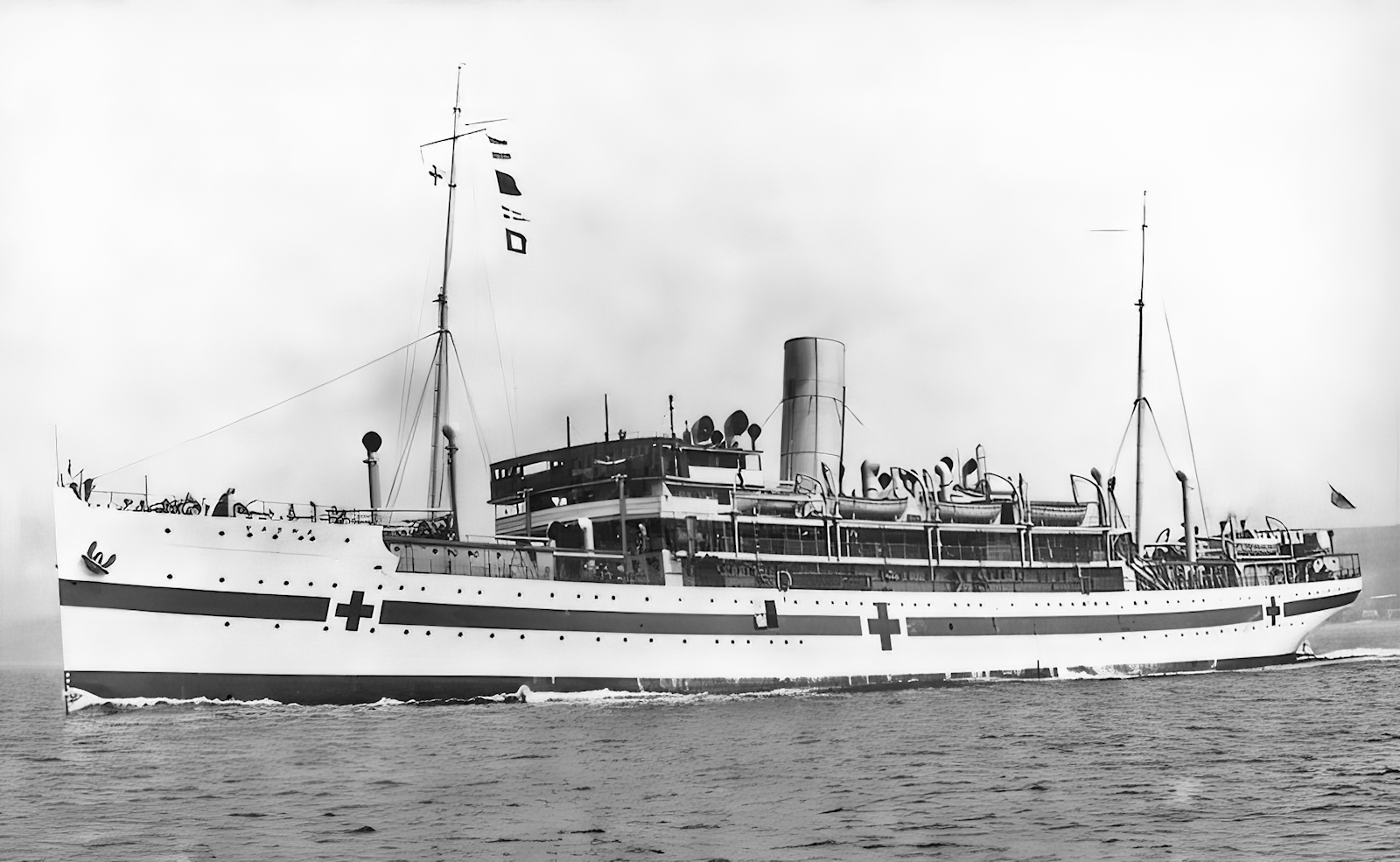
VASNA on completion of her conversion into an Indian Expeditionary Force hospital ship in 1917
She made monthly round trips, Bombay to Basra, calling at other ports on passage such as Karachi. In March 1918 she was redesignated as an Ambulance Transport Ship, and continued in service on this route until February 1921. On September 13th 1918 Lt. Col V.E.N. Lindsay, I.M.S. took over as O.C. Troops. He remained in charge until the end of January 1920 when Major W.S. Nealor, I.M.S. assumed command.
On release from military service VASNA was returned to her owners British India Steam Navigation Co. Ltd at Bombay and was converted back to accommodate passengers. The SS VASNA was then put into regular commercial service following the same route as she had during the war, Bombay-Karachi-Bushire-Basra.
Requisitioned again 1939 for conversion into a Hospital Ship
In August 1939 the S.S. VASNA was requisitioned at Bombay by the Admiralty, again she was to be converted into a hospital ship. She was converted in the Mazagon Dock ltd. Bombay under the supervision of the Principal Sea Transport Officer of the Royal Indian Navy. Her conversion was not to be straightforward; unlike the conversion of 1917, which resulted in accommodation for 558 wounded and sick but only 57 cot cases, the current conversion would only allow for 279, all cot cases. Work included creating spaces for use as an operating theatre, X-Ray room, a dispensary and additional toilet and washing areas and accommodations for the small female contingent. The most obvious outward sign of the work was the addition of wooden deck structures aft; due to material shortages and the urgency attached to her conversion unseasoned wood was used, they were badly planned and crudely finished, and within a few weeks seams were gaping and the structures were no longer weather- proof.

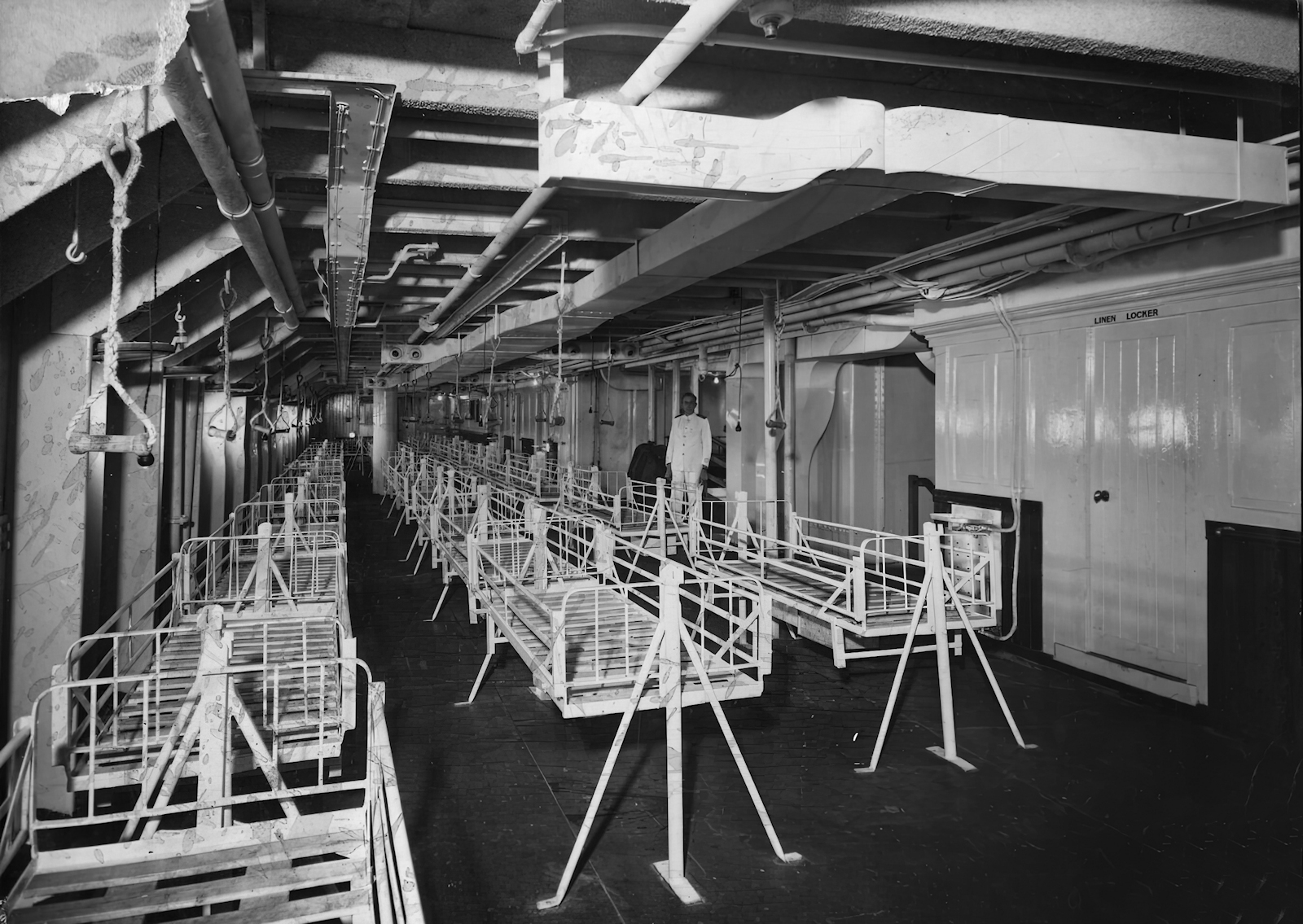
Examples of passenger decks converted into Hospital Wards. Left fixed single and double cots, right: gimbaled cots able to keep patients on an even keel in conditions were the ship would roll. Items P1892_05 & P1892_06 from atom.drisa.co.za
Accommodation for medical officers and nursing sisters was barely adequate for tropical service, but was accepted with slight modifications. On the other hand the accommodation of sick berth staff was unsatisfactory, an example being one mess deck measuring 40 ft. Long, 9 ft. wide, and 7 ft. high, adjacent to the engine room and the galley, was home for 22 sick berth attendants. Sanitary arrangements were poor, the main fault being a tendency for lavatories to flood, and lack of fresh water bathing facilities. The ship carried a space for storing ice, but no refrigerating plant. Having been operating in the Persian Gulf VASNA had good Ventilation and this was satisfactory throughout the ship.
She was commissioned as Hospital Ship No.4 on October 2nd, She was manned by the a Merchant Navy crew under Captain R. H. A. Bond, the hospital was under the command of Surgeon Captain F. G. Hunt, MRCS, LRCP, Medical Officer in Charge with a staff of 8 doctors 1 Arrant Ward master, 1 Superintending Sister, 6 Nursing Sisters, and 57 sick Berth Attendants.
She was to remain at Bombay initially, presumably as a Base Hospital Ship of the Eastern Fleet and received her first patients on the October 17th. In the New Year she was reallocated to operate as the Base Hospital Ship at Scopa Flow, the Orkney Islands as part of the Home Fleet and sailed from Bombay in early February 1940. She arrived at Combo on February 8th, remaining there until March 17th when she sailed for her passage to the UK. She called at Aden on the 25th, Suez on the 30th, entered the Suez Canal on the 31st, and arrive at Alexandria April 1st.
After a brief stopover at Alexandria she sailed on April 3rd, called at Malta on the 6th, Gibraltar on the 10th and arrived at Southampton April 15th. She was now taken in hand by a local dockyard on the 18th for a month of repairs and remedial work to be carried out. On completion VASNA sailed from Southampton on May 20th for Scapa.
Allocated for service with the Home n Fleet at Scapa Flow, Orkney Islands
VASNA arrived at Scapa Flow on May 25th 1940 to join the Home Fleet. Only a week later she was involved in Operation Alphabet, the seaborne evacuation of 24,500 Allied troops in Norway as German forces continued their invasion of Norway.
She joined two other Hospital Sips, HMHS ABA (Base hospital Ship, Scapa until March then transferred to the Army and RAMC manned) and HMHS ATLANTIS (Navy manned) in receiving casualties from Narvik. The first of two troop ship convoys composing of 15 troop transports arrived on June 2nd at Harstad to begin loading, over the next 5 nights 24,500 men were embarked. A second convoy of 7 troop ships arrived on June 7th and over the next two days a further 10.0000 men were embarked, completing the evacuation operation. . VASNA appears to have made two crossings from Scapa to Harstad to embark casualties, arriving back at Scapa on the 6th and the 13th.
As the Scapa Base Hospital Ship VASNA was moored in Kirkwall harbour between periods at sea, and she fulfilled this role until November when was allocated for temporary service as the Base Hospital Ship at Freetown, Serra Leone. She sailed from Kirkwall on November 20th for Liverpool to enter a dockyard for further work prior to leaving the UK.
She arrived at Liverpool on November 25th and was to undergo repairs and receive alterations to her hospital installation prompted by issues brought to light during her casualty evacuations in Norway. The work was completed on January 16th 1941 and after storing ship she sailed for Freetown on the 29th.
She arrived at Freetown on February 15th to relieve HMHS OXFORDSHIRE which sailed for South Africa for repairs at Simon’s Town; this was to be a short assignment however, she sailed to return to the UK on Sailed May 29th. After calling at Ponta Delgada, the Azores on June 5th she arrived back at Liverpool on the 14th. After receiving repairs she sailed for Scapa on July 1st, arriving thereon the8th to resume duty as the Base Hospital Ship.
Allocated for service with the Eastern Fleet
VASNA remained at Scapa until January 1942 when she was reallocated for service with the Eastern Fleet. She sailed from Scapa on January 29th bound for Avonmouth to enter a Dockyard for a refit, arriving there on the 31st. While at Avonmouth Surg. Capt. R. A. Brown, MB, CHB arrived on March 4th to assume the post of Medical Officer in Charge.
On completion of her dockyard work and a post refit shakedown in the Bristol Channel VASNA sailed for Ponta Delgada on March 15th. Later that day she collided with the430-ton freighter MIRIAM THOMAS in St George’s Channel, 7 miles south of Chicken Rock, in the Irish Sea. The then unidentified freighter sank about 15 miles south of Chicken Rocks near Holyhead, all eight men aboard perished. VASNA suffered damage to her stem and her starboard propeller but was still seaworthy and was order to Liverpool for repairs. She sailed from the Mersey on March 25th to resume her passage to Ponta Delgada.
She arrived at Ponta Delgada on March 31st where she was to be involved in a second collision on the afternoon of April 1st; the Portuguese Destroyer DAO ran into her while moored in the harbour in a dense fog, minor damage was done to both vessels. Deemed seaworthy VASNA continued her passage to Ceylon, calling at Freetown on the 10th and arriving at Cape Town on the 22nd where she was to receive repairs to the damage caused by the collision with the DAO. The work took a fortnight to complete, she sailed on May 4th for Durban where she arrived on the 8th. On May 22nd sailed for Colombo, arriving there on June 6th to join the Eastern Fleet. She was to spend a month in port at Colombo before sailing again on July 6th for Kilindini where she was to take up the duty of Base Hospital Ship on her arrival on the 16th.
VASNA remained at Kilindini/Mombasa until November 19th before sailing for Bombay for repairs, calling at the Seychelles, Madagascar (Diego Suarez), Addu Atoll, and Colombo before arriving at Bombay on December 13th. Work began on Christmas Eve 1942 and was complete on January18th 1943. She sailed to return to Mombasa on the 20th, calling at the Seychelles to arrive on February 26rd. She required further repair work by the end of March and sailed from Mombasa on the 31st for Durban to enter Naval Dockyard. Arriving on April 10th work began the next day and was completed on May 2nd.
While in South Africa she was nominated for temporary service on loan to the Mediterranean Fleet and on leaving the Dockyard she sailed for Bombay on May 5th, this time calling at Mauritius, Diego Garcia and Addu Atoll before arriving on May 31st.
Loaned to the Mediterranean Fleet
At Bombay VASNA was due a crew change before sailing on June 6th for Tripoli via Aden and port Suez. On arrival at Tripoli on July 10th she joined the hospital Ships OPHIR which had arrived on the 9th and VITA on the 11th to provide support for Operation HUSKY, the Allied invasion of Sicily which began on the night of 9–10 July 1943 and ended on August 17th. VASNA remained at Tripoli until July 27th before sailing for Alexandria where she arrive on the 30th. She made one trip to Syracuse, Sicily to embark causalities before being released from HUSKY operations. She now required further dockyard attention and was ordered to return to the UK for urgent remedial work to be carried out; she sailed from Alexandria on August 27th.
On arrival at Avonmouth on September 4th ache was prepared for entering Dry Dock, being docked on the 7th, and undocked on the 9th. She was in Dockyard hands for five weeks, sailing to return to the Mediterranean to resume operations on loan, arriving at the port of Algiers on November 5th 1943.
She now made a series of calls at ports on passage to Alexandria, calling at Catania, Scilly on November 14th, and Bari on the heel of Italy on the 16th. From Bari she called at Brindisi on the 17th then sailed for Alexandria, arriving there on the 20th. She sailed from Alexandria on the 23rd to arrive at Bizerte, Tunisia on the 27th and arrived at Taranto, Italy on the 3oth. Three days later she sailed to return to Algiers, arriving there on December5th. Two days later she sailed for the eastern Mediterranean again, arriving at Syracuse on December 9th. After a week in port she moved up the coast to call at Catania. She remained in the Syracuse area for the remainder of December 1943, sailing for Toronto on January 9th 1944, arriving on the 14th. After an overnight stop she sailed for Tripoli calling there on the 17th before sailing for Alexandria where she was released from duty with the Mediterranean Fleet.

VASNA Hospital Ship No.4
Return to operations with the Eastern Fleet
VASNA arrived at Port Said on January 23rd and entered the Suez Canal for passage to Bombay via Aden and Karachi; she spent 7 days at Port Suez during which time she embarked sick and injured men for passage. She arrived at Bombay on February 14th 1944. A week later she sailed for the first of two round trips to Port Suez to embark patients, arriving back on March 17th, sailing again on the 23rd she completed her second run on April 15th. She then proceeded to Karachi on the 17th where Surg. Commander D. R. F. Bertram, OBE, MB, MS, DMR arrived on board to take over as Senior Medical Officer before entering the Persian Gulf for a voyage to Basra, arriving there on the 25th. After embarking patients she sailed to return to Karachi arriving on May 1st. VASNA’s old machinery was again showing its age and more repair was required; from Karachi she sailed for Durban, calling at Bombay, Colombo and Mauritius. Arriving at Durban on May 24th she was placed in Dockyard hands for repairs, on completion she sailed on June 6th for Mombasa on route to Suez where she arrived on the 22nd to embark more patients for transfer to Bombay, arriving there on July 3rd. She now made a round trip to Karachi before sailing for Trincomalee, arriving on July 18th. She remained at Trincomalee for 2 months, arriving in Colombo on September 18th before sailing for the Bay of Bengal in mid-October, arriving at Sandheads on the 17th where she stopped for 5 days before proceeding to Chittagong, calling there on the 23rd before arriving at Calcutta on the 25th.
VASNA operated in the Bay of Bengal making round trips Calcutta to Sandheads, and Chittagong with the occasional call at Madras. In January 1945 she was allocated to support operations off the Arakan coast of Burma and moved to Akyab, arriving on the 20th; she was to be part of the covering force for seaborne landing on Ramree Island, Operation MATADOR an amphibious assault to capture the strategic port of Kyaukpyu and its nearby airfield which commenced on the 21st. On January 26th she was part of the covering force for Operation SANKEY, the landing on Cheduba Island by Force 'Wellington' a force of 500 Fleet Royal Marines embarked aboard the cruisers NEWCASTLE (Rear Admiral A.D. Read, CB, KENYA, and NIGERIA, The marines made a seaborne assault in LCP(M)s but on coming ashore, they found the island deserted. Her services not being required VASNA arrived back at Chittagong, on the 28th, and Calcutta on the 31st. On February 9th she sailed for a round trip to collect sick and injured from Kyaukpyu arriving there on the 12th via Akyab, calling at Chittagong, on the 14th, and arriving back at Calcutta on the 17th.
She was released from operations off Burma on February 23rd and arrived back at Colombo on February 28th 1945. She then sailed for Durban, Via Mombasa for further repairs. She arrived at Durban on March 18th and was to remain in Dockyard hands until early June, sailing for Mauritius on June 8th on passage to Ceylon, arriving Colombo on the 24th and Trincomalee on the 30th.
Reallocated for service with the British Pacific Fleet
While at Trincomalee VASNA adjusted her patient load, embarking invalids for passage home to Australasia and New Zealand who arrived from Suez aboard the Hospital Ship OPHIR. She sailed on July 7th for Sydney via Darwin, disembarking patients at Darwin on the 18th and arriving in Sydney Harbour on July 28th to deliver the remainder of her Australian charges. She sailed the following day for Wellington, arriving on August 2nd to disembark her reaming patients. After a week in harbour making preparations she sailed for Manus in the Admiralty Islands to join the Fleet Train; the Japanese surrendered on August 15th while she was on passage, arriving at Seeadler Harbour on August 20th.
After two weeks at Manus VASNA sailed on September 4th for Japan via Guam, calling there on September 9th before arriving at Tokyo Bay on the 14th to relieve the large Dutch Hospital Ship HMHS TJITJALENGKA which, along with the US Navy Hospital Ship BENEVOLENCE, and he US Army Hospital Ship MARIGOLD had begun the task of Prisoner of War clearance and evacuation at Yokohama on August 30th. These three ships were tied up to the harbour wall at Yokohama alongside a massive warehouse which had been established as a POW reception Centre to receive the released allied prisoners of war as they were liberated from their internment camps in Japan. The Americans went down one side of the warehouse and the British, Canadians, New Zealanders and Australians down the other. Liberated prisoners were taken from camps in the interior to Yokohama, on arrival the men were stripped and fumigated, issued with replacement clothing and were medically examined.
Liberated British and Commonwealth personnel fit to fly out had been taken to an air strip near Tokyo for passage to Manilla, those who could go by sea were ferried out to ships in Tokyo bay; those requiring medical treatment had been embarked in the larger Dutch Hospital Ship TJITJALENGKA. Amongst those liberated were civilian internees including women and children, these were transferred to the escort carriers RULER and SPEAKER which had been cleared of aircraft and hastily converted to accept them. At 13:00 on September 3rd SPEAKER was the first allied ship to depart from Tokyo Bay bound for Manilla with 477 liberated allied personnel. All the men that TJITJALENGKA received needed medical care, many were extremely thin and malnourished, suffering from vitamin deficiencies; some required surgical care as a result of their brutal treatment in the camps. VASNA secured alongside at Yokohama replacing TJITJALENGKA which was ready to sail on September 16th; by this date at least 14,000 ex POWs had passed through the reception Centre. On sailing TJITJALENGKA was carrying 459 New Zealanders and 46 Australians bound for New Zealand and Australia.
VASNA spent 10 days at Yokohama embarking more liberated PPOWs requiring medical care before sailing for Okinawa late afternoon on September 25th in company with the Destroyer HMAS NORMAN. The two ships arrived at Okinawa on the 28th but were delayed in contusing their voyage by a severe Typhoon which required them to alter course to avoid the weather. They arrived at Manus on October 14th, and after taking on fuel continued on for Sydney the next day. VASNA arrived at Sydney on the October24th with 73 sick evacuated from Japan and Okinawa.
After disembarking her patients VASNA was taken in hand by a Sydney Dockyard for repairs. On October 30th Captain R. H. A. Bond left the ship after 6 years as master, command passed to Captain E. C. Brookes (Commodore, British India Steam Navigation Co.) On completion of repairs she sailed for Hoping Kong on November 26th, calling at Manus on December 4th and Manila on the 12th, arriving at Hong Kong on December 16th. Here she acted as a Base Hospital Ship treating both in patients and out patients before sailing to return to Sydney on January 26th 1946, arriving at Sydney on February 4th.
Release from Wartime service
After 6½ years’ service as a Naval Hospital Ship VASNA was to be prepared for decommissioning and returned to her owners; she sailed from Sydney on February 13th 1946 bound for Bombay, calling at Fremantle on the 21st and arrived at Colombo on March 5th. Here her medical staff left the ship and she was destored in preparation for return to merchant service. VASNA sailed from Colombo on March 14th, arriving at Bombay on the 17th were she was released from military service and returned to the British India Steam Navigation Co. Ltd., on April 4th.
VASNA was an old ship, built in 1917 and she was described as badly converted and always ‘a make-shift venture’, ‘a source of expense' and grew to be associated with repeated misfortunes. However, during the whole of her 6½ years’ service in the Second World War approximately 12,400 patients were admitted and 30,767 out- patients attended the ship. She operated in the North Sea, the South Atlantic, The Indian Ocean, the Mediterranean Sea and the Pacific Ocean, and was involved in supporting the evacuation of Norway and the seaborne assaults on Scilly and the Arakan coast of Burma when she was not operating as a static Base Hospital Ship.
Civilian Service
After a spell in a Bombay Dockyard commencing on April 25th VASNA entered commercial service on June1946, sailing from Bombay on June 10th and operating between Mombasa, Dar-es-Salam on the east coast of Africa. She continued in service on the Persian Gulf and East Africa route until 1951 when she was withdrawn from service and sold for breaking. She was purchased by the British Iron & Steel Co. for £44,500 and sailed for the UK where she was broken for scrap at Blyth by Hughes Bolckow Shipbreaking Co Ltd., in April 1951.
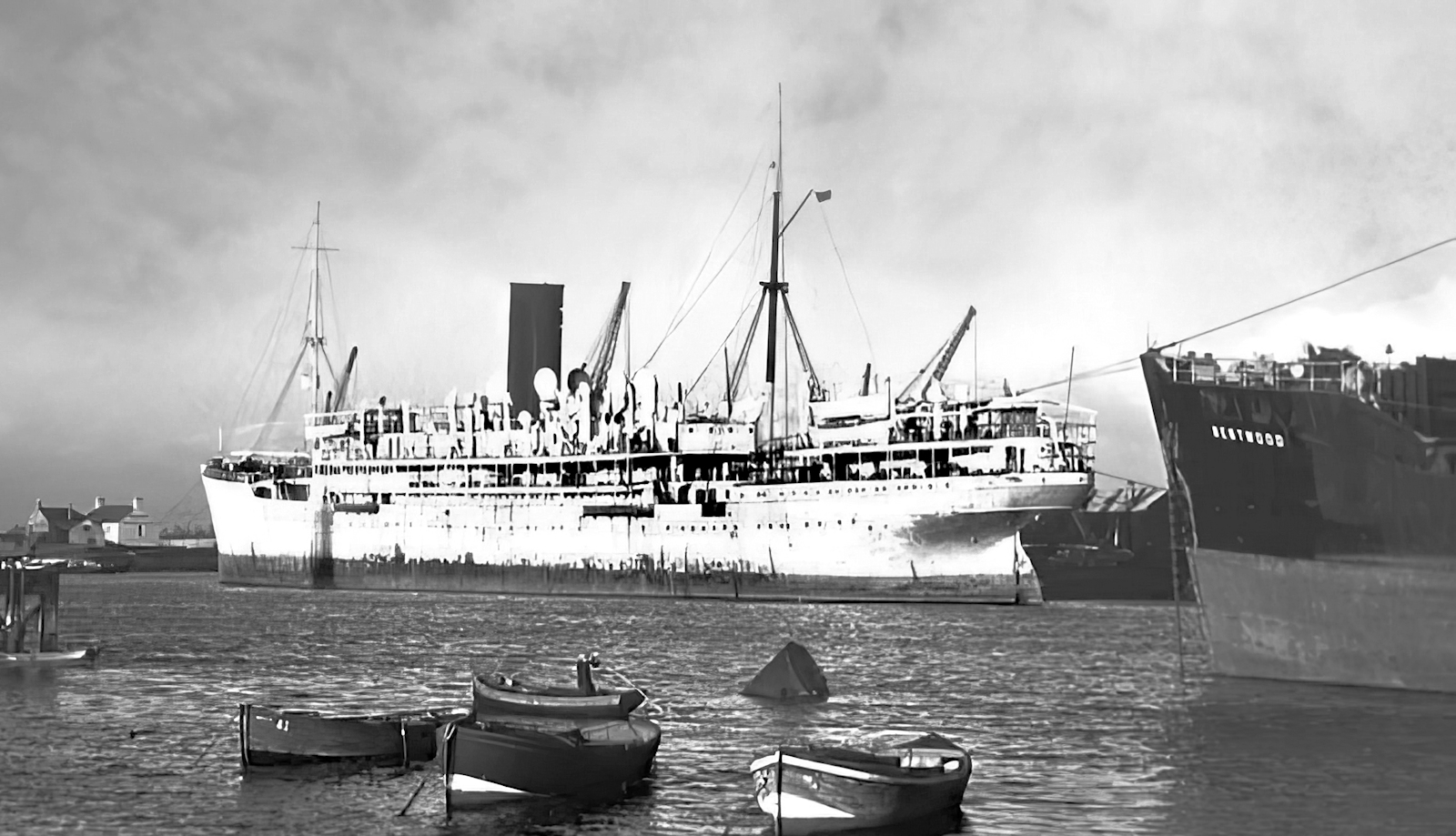
VASNA at Blyth in 1951 waiting scrapping.
VASNA Hospital Ship No.4
Last modified: 02 June 2023
Primary information sources
Additional sources:
BT-389-31-48 Ship's record card held by the UK National Archive
(1954) Surgeon Commander J. L. S. COULTER, D.S.C., R.N., ‘THE ROYAL NAVAL MEDICAL SERVICE’ London, Her Majesty's Stationery Office
Comments (0)